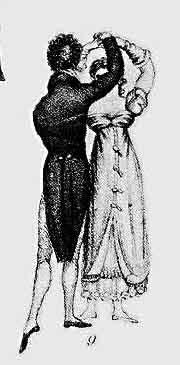- Historical Dance
- Jazz Age Social Dancing ("The Modern Dances")
- Ragtime Dance - the One Step
- Regency Dance
- "Mr Nelson's System of Simplified Regency Dance"
- An Analysis of Country Dancing - 1808
- Cotillions and Country Dances 1792
- Elements of the Art of Dancing - 1822
- The Complete System of English Country Dancing - 1815
- The Scholar's Companion - Cotillions and Country Dances - 1796
- Thos Wilson's Quadrille Instructor - Ca 1816
- Thos. Wilson's Description of Regency Waltzing - 1816
- Treasures of Terpsichore - 1816
- Victorian Dance
The German Waltz

"The following Movements compose German Waltzing:
The left Foot is passed into the second position on the flat Foot. followed by two Coupee, and made in the same place, one with each Foot; the right Foot passed forward into the fourth position, and the left Foot brought forward with a Rise or slight Spring into the fifth· position, and immediately afterwards bringing the right Foot forward into the Fourth position" (Wilson).
The dance does not really look, to the modern eye, at all waltz-like, with its springing step and kicks. It seems to have been an evolutionary dead end, and did not catch on like its French cousin.
For the rest of this, I will focus on the French Waltz, which also contains a lot of elements which also have not survived, but which is clearly the precursor of what we have come to expect when we hear "waltz".
